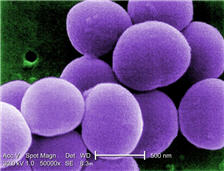Staphylococcus aureus in Healthcare Settings
General Information about Staphylococcus aureus
Staphylococcus aureus [staf I lō-kok is aw ree us] (staph), is a type of bacteria that about 30% of people carry in their noses. Most of the time, staph does not cause any harm; however, sometimes staph causes infections. In healthcare settings, these infections can be serious or fatal, including:
- Bacteremia or sepsis when bacteria spread to the bloodstream.
- Pneumonia, which predominantly affects people with underlying lung disease including those on mechanical ventilators.
- Endocarditis (infection of the heart valves), which can lead to heart failure or stroke.
- Osteomyelitis (bone infection), which can be caused by staph bacteria traveling in the bloodstream or put there by direct contact such as following trauma (puncture wound of foot or intravenous (IV) drug abuse).
Staph bacteria can also become resistant to certain antibiotics. These drug-resistant staph infections include: Methicillin-resistant Staphylococcus aureus (MRSA), Vancomycin-intermediate Staphylococcus aureus (VISA), and Vancomycin-resistant Staphylococcus aureus (VRSA)
- More information on:

For more images of this bacterium, search the Public Health Image Library
Populations at risk for Staphylococcus aureus infection
Anyone can develop a staph infection, although certain groups of people are at greater risk, including people with chronic conditions such as diabetes, cancer, vascular disease, eczema, and lung disease. In a healthcare setting, the risk of more serious staph infection is higher because patients often have weakened immune systems or have undergone procedures such as surgery or have intravenous catheters.
Prevention of Staphylococcus aureus infection
CDC has published guidelines and recommendations that healthcare professionals should follow to prevent the spread of staph and other bacteria in their healthcare facilities (see recommendations and guidelines below).
Recommendations and Guidelines
For Healthcare Professionals
Adherence to basic infection control practices is the key to the prevention and control of staph infections in healthcare settings.
The Healthcare Control Practices Advisory Committee (HICPAC) provides recommendations in the 2007 Guideline for Isolation Precautions: Preventing Transmission of Infectious Agents in Healthcare Settings.
Multidrug-resistant Organisms (MDRO) Prevention and Control
HICPAC provides the following MDRO guidelines to preventing infections, which will help reduce the burden of MDROs in healthcare settings.
Procedure-associated Infection Prevention and Control
Many times surgeries present opportunities for procedure-associated infections. Healthcare personnel can help to prevent surgical site infections (SSIs) by following HICPAC’s important SSI Guidelines [PDF - 270 KB] .
Get email updates
To receive email updates about this page, enter your email address:
Contact Us:
- Centers for Disease Control and Prevention
1600 Clifton Rd
Atlanta, GA 30333 - 800-CDC-INFO
(800-232-4636)
TTY: (888) 232-6348 - New Hours of Operation
8am-8pm ET/Monday-Friday
Closed Holidays - cdcinfo@cdc.gov


